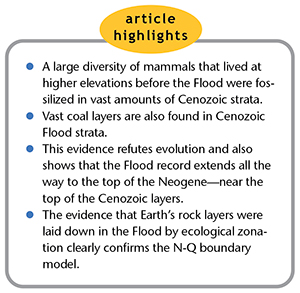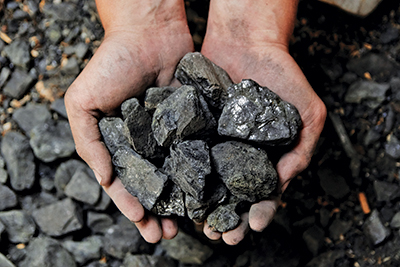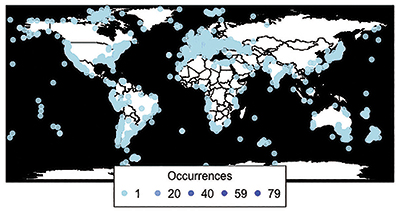Jeffrey P. Tomkins, Ph.D., and Tim Clarey, Ph.D.
 Extensive rock record research performed by ICR geologist Dr. Tim Clarey across four continents has revealed that the sedimentary strata laid down in the global Flood extend nearly all the way to the top of the Cenozoic unit in the geologic column.
Extensive rock record research performed by ICR geologist Dr. Tim Clarey across four continents has revealed that the sedimentary strata laid down in the global Flood extend nearly all the way to the top of the Cenozoic unit in the geologic column.
ICR scientists Dr. Jeffrey Tomkins and Dr. Clarey have also documented fossil discoveries in the upper Cenozoic rock layers—such as Cenozoic coal seams and several types of Cenozoic mammal fossils—that further confirm the N-Q boundary.3 These Late Cenozoic fossils were buried during the receding phase of the Flood and typically represent plants and animals that lived at higher elevations in the pre-Flood world.4
Cenozoic Coal Seams
One of the most powerful paleontological evidences of the high-Flood/post-Flood boundary (N-Q) is the presence of huge Paleogene (Early Cenozoic) coal beds formed from mostly angiosperm (flowering) plants.4 For coal beds to form, enormous amounts of plant material must be transported and buried rapidly before it decays. Compared to Carboniferous coal beds formed earlier in the Flood that contain tropical coastal vegetation, the more massive Cenozoic coal seams were formed from plants and trees that grew at higher elevations in the pre-Flood world.3 These higher-elevation plants would have been ripped up late in the Flood and buried during the receding phase in large sedimentary basins where they would have been easily trapped.

An excellent example of massive Cenozoic coal deposits in North America can be seen in a large region known as the Powder River Basin that extends from the center of eastern Wyoming up into the lower third of Montana.5,6 This coal layer contains some of the largest known reserves of low-sulfur subbituminous (black lignite) coal in the world. Approximately 42% of the present coal production in the United States comes from the Powder River Basin. At least six coal beds in this basin exceed 100 feet in thickness, with some more than 200 feet thick in places, such as the Big George coal layer. Other extensive but thinner Cenozoic coal deposits can be found across the midwestern and southern states.6
Huge Cenozoic coal deposits aren’t exclusive to North America but have also been mapped out across South America. These late-Flood Cenozoic coal seams are the thickest and most extensive across that continent as well.6,7 It is estimated that these beds alone make up about one half of all coal in South America, and the total tonnage has been estimated to be greater than any other geologic system or combination of systems in that continent.
But Cenozoic coals aren’t just found on land. Oil-well drilling data in the South China Sea about 175 miles off the coast of Borneo have revealed a large region of bedded coals buried in Oligocene (Middle Cenozoic) strata that “is both thick and rapidly deposited.”8 The intense energy of the receding phase of the Flood could easily have transported and buried these land plants out in the deep sea in late-Flood continental runoff similar to that which occurred in North America with the Whopper Sand deposit in the Gulf of Mexico.9
Land Mammal Fossils
The Cenozoic Era is often referred to as the Age of Mammals primarily because most kinds of mammals make their first fossil appearances in these strata. As with other types of fossilized creatures throughout the rock record, these land-based mammals appear suddenly without any evolutionary precursors, and the ones that are not now extinct look similar to their living counterparts. Most of these fossilized mammals would have been living at higher, more temperate elevations than the dinosaurs and thus would have been buried in the uppermost Flood layers of the Cenozoic—which is exactly where we find them.

The fact that the majority of mammal fossils make their first appearances in Cenozoic sediments confirms that the depositional processes of the global Flood were still occurring throughout these late-Flood rock layers. The land mammals in these layers that are now extinct would likely have been represented aboard Noah’s Ark but have since died off due to loss of habitat or human hunting. Examples of land mammal kinds making their first appearance in these sediments include rodents, horses, rhinoceroses, elephants, dogs, cats, pigs, cattle, sheep, antelope, and gazelle.
Marine Mammal Fossils

In addition, many kinds of whales and other marine mammals show up in these upper Flood layers, which isn’t surprising because many Cenozoic sediments are of marine origin, especially across Europe and the Middle East.10 It’s likely that the large, bloated, buoyant carcasses of dead marine mammals would have been some of the last to be buried during continental runoff in the receding phase of the Flood. In fact, whale fossils are located along the coastal margins of nearly every major continental landmass and are also found across the entire continent of Europe (Figure 1).11 This aligns with findings from ICR’s Column Project, which has shown that Cenozoic marine sediments cover most of Europe.10
ICR scientists disagree with creation scientists who place the post-Flood boundary at the end of the earlier Cretaceous system (K-Pg or Cretaceous-Paleogene). One good reason is that it’s hard to plausibly explain the sudden appearance of whale fossils above this boundary. Some advocates for a lower boundary claim these large marine mammals rapidly and radically changed from their ancestors that walked on legs out of the Ark.12 But did whales really descend by modifications from land-dwelling ancestors coming off the Ark? Creationists who believe that supposed whale ancestors were on the Ark should offer a biological mechanism to account for the numerous and exceptionally large changes in anatomy and physiology in an extremely short time frame of only about 200 years.12
Some creationists suggest these whales were fossilized in localized post-Flood catastrophes, but the pervasive global distribution of whale fossils refutes this claim. Even secular research has shown that a massive global extinction event that involved many marine mammals occurred near the top of the Pliocene.13
Monkey Fossils
Another interesting group of mammals that further confirms a higher N-Q Flood/post-Flood boundary are monkeys whose fossils have been found across multiple continents. Both monkey and ape fossils appear suddenly in the geologic record. Monkey fossils of the same type have been found in the same Cenozoic rock layers of completely separate continents.14 To account for these inconvenient data, evolutionists have actually claimed that monkeys rafted back and forth between Africa and South America on the open ocean.
While the monkey fossil data lend no support to ideas of monkey evolution, they do support that the Flood sediments extend through the Cenozoic. The reason we find monkeys and apes in Cenozoic strata is that they were buried late in the Flood with animals living at higher elevations. The monkeys lived in these more temperate ecosystems with other large mammals, birds, insects, and many angiosperm plant species. This explanation also supports the idea of these fossils being formed during the receding phase of the Flood as massive continental runoff occurred following the separation of continents from the original Pangaea supercontinent.
Exotic Mammal Fossils
Paleontologists recently discovered a fossil of a new type of extinct ferocious-looking mammal bigger than any lion or tiger living today.15 This bizarre creature highlights the wide diversity of now-extinct large, exotic mammal species that were preserved as fossils in the sedimentary rocks of the Cenozoic deposited during the late stages of Noah’s Flood. The newly found creature is classified as Hyainailourine hyaenodont, a group of creatures that are among the largest carnivorous land mammals known, although they aren’t placed in the order Carnivora. This creature was even larger than a polar bear, with a skull as big as a rhinoceros and huge, piercing canine teeth. Despite the sharp teeth, these creatures lacked bone-crushing molars and were thought to do more tearing and shredding than grinding. Their paws lacked the rotational ability of cats’ paws and were more wolf-like, as were their overall skeletons.
This hyaenodont fossil was recently discovered in the drawer of a museum. It had actually been dug up in Kenya over three decades earlier while researchers were studying fossil apes. The creature was found in early Miocene strata and is allegedly 22 million years old, according to evolutionary dating. As the secular story goes, “Hyaenodonts arose in Asia in the late Paleocene and quickly spread across the northern continents in the early Eocene.”16 The terms “arose” and “quickly spread” are evolution-speak, meaning that this unique group of creatures appeared suddenly all over the world with no evolutionary precursors. Like the other mammals, hyaenodonts were buried late in the Flood along with other creatures living at higher elevations in more temperate environments.
So, how do we put this new hyaenodont fossil discovery in the context of a creation model? And why aren’t these large, ferocious animals roaming across Earth today? The Bible tells us that breeding pairs of various animal kinds were brought onto Noah’s Ark then released after the Flood. Hyaenodonts (in some form) were likely among these creatures, but because in time their vicious and predatory nature represented a threat to humans—and especially livestock—they were likely hunted to extinction.
Early Flood Boundary Advocates Promote Implausible Physical Changes
Some fellow creationists promote a Cretaceous-Paleogene (K-Pg) post-Flood boundary lower in the sedimentary rock record. In doing so, they have extreme difficulty explaining the fossils and sediments of the Cenozoic and resort to untenable ideas of rapid saltational (abrupt, substantial mutational change) physical changes.17
As mentioned above, one of the major problems with this idea is that whale fossils have been found across the entirety of Europe and the coastal margins of nearly every major continental landmass and at the same stratigraphic levels, negating their supposed burial in localized post-Flood catastrophes. In addition, many first appearances of numerous plants and animals occur in Cenozoic sediments. Besides the obvious paleontological data, the data from extensive global megasequences clearly show that the Flood’s depositional processes occurred on a global scale through most of the Cenozoic, also known as the Tejas Megasequence. Thus, evidence from both geology and paleontology debunks the notion of an early Flood boundary and hence the supposed necessity of both rapid saltation and numerous global post-Flood catastrophes.
Conclusion
In 1996, ICR founder Dr. Henry Morris stated, “The vertical order of the strata is thus primarily a function of vertical elevation of environmental habitat, and not evolutionary progress.”18 The paleontological evidence clearly shows that the diverse plants and mammals inhabiting higher elevations and more temperate ecological zones aren’t just buried in Cenozoic Flood strata but also make their first appearances in these rocks with no previous evolutionary history.
Thus, when we combine the paleontology of the Cenozoic rocks with the vast amounts of sedimentary strata deposited therein, we not only have a sound case for refuting evolution but also show that the Flood record extends all the way to the top of the Neogene, close to the top of the Cenozoic layers. This model clearly confirms Dr. Morris’ original prediction of the correlation of rock layers laid down during the Flood by ecological zonation rather than evolution—and more importantly reveals a Flood timeline that supports biblical creation and not the evolutionary model.
References
- Clarey, T. 2019. Rocks Reveal the End of the Flood. Acts & Facts. 48 (5): 9.
- Clarey, T. Data Lead to Correct Post-Flood Boundary. Creation Science Update. Posted on ICR.org July 17, 2018, accessed April 27, 2020.
- Clarey, T. L. 2017. Local Catastrophes or Receding Floodwater? Global Geologic Data that Refute a K-Pg (K-T) Flood/Post-Flood Boundary. Creation Research Society Quarterly. 54 (2): 100-120.
- Clarey, T. 2020. Carved in Stone: Geological Evidence of the Worldwide Flood. Dallas, TX: Institute for Creation Research, 312-353.
- Scott, D. C. and J. A. Luppens. 2013. Assessment of Coal Geology, Resources, and Reserve Base in the Powder River Basin, Wyoming and Montana. Fact Sheet 2012-3143, U.S. Geological Survey.
- Clarey, T. L. 2017. Floating Forest Hypothesis Fails to Explain Later and Larger Coal Beds. Journal of Creation. 31 (3): 12-14.
- Weaver, J. N. and G. H. Wood, Jr. 1994. Coal Map of South America. Coal Investigations Map C-145, U.S. Department of the Interior, U.S. Geological Survey.
- Lunt, P. 2019. A new view of integrating stratigraphic and tectonic analysis in South China Sea and north Borneo basins. Journal of Asian Earth Sciences. 177: 220-239.
- Clarey, T. A Whopper Mystery for Nearly 20 Years. Creation Science Update. Posted on ICR.org April 22, 2020, accessed June 5, 2020.
- Clarey, T. L. and D. J. Werner. 2019. Compelling Evidence for an Upper Cenozoic Flood/Post-Flood Boundary: Paleogene and Neogene Marine Strata that Completely Surround Turkey. Creation Research Society Quarterly. 56 (2): 68-75.
- Tomkins, J. P. and T. Clarey. 2019. Whale Fossils Confirm Post-Flood Boundary. Acts & Facts. 48 (12): 9.
- Wise, K. P. 2009. Mammal Kinds: How Many Were on the Ark? In Genesis Kinds: Creationism and the Origin of Species. T. C. Wood and P. A. Garner, eds. Eugene, OR: Wipf and Stock Publishers.
- Pimiento, C. et al. 2017. The Pliocene marine megafauna extinction and its impact on functional diversity. Nature Ecology & Evolution. 1 (8): 1100-1106.
- Tomkins, J. P. Monkey Fossil Reveals Diversity and Flood Boundary. Creation Science Update. Posted on ICR.org June 11, 2019, accessed April 27, 2020.
- Borths, M. R. and N. J. Stevens. 2019. Simbakubwa kutokaafrika, gen. et sp. nov. (Hyainailourinae, Hyaenodonta, ‘Creodonta,’ Mammalia), a gigantic carnivore from the earliest Miocene of Kenya. Journal of Vertebrate Paleontology. 39 (1): e1570222.
- Prothero, D. R. 2017. The Princeton Guide to Prehistoric Mammals. Princeton, NJ: Princeton University Press.
- Wise, K. 2017. Step-Down Saltational In-trabaraminic Diversification. Journal of Creation Theology and Science Series B: Life Sciences. 7: 1-9.
- Morris, H. M. and Henry M. Morris III. 1996. Creation and the Flood. In Many Infallible Proofs: Evidences for the Christian Faith. Green Forest, AR: Master Books, 298.
* Dr. Tomkins is Director of Research and Dr. Clarey is Research Associate at the Institute for Creation Research. Dr. Tomkins earned his Ph.D. in genetics from Clemson University, and Dr. Clarey earned his Ph.D. in geology from Western Michigan University.













